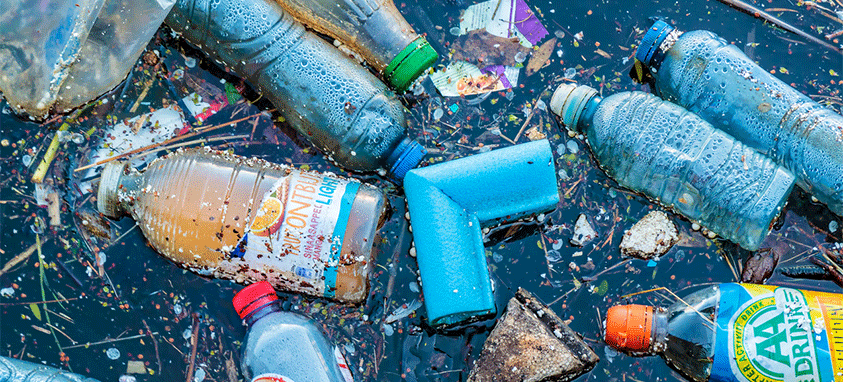Planners can lead the way to healthier oceans
In the 1967 film The Graduate, Dustin Hoffman is pulled aside at a cocktail party by a guy who says he has one word of advice for a young man about to enter the world of work: “plastics.”
Hoffman’s character chooses instead to have an affair with a middle-aged neighbor, the irresistible Mrs. Robinson, but that did nothing to lessen the import of plastics across the globe in the decades since. The Great Pacific Gyre, a floating garbage patch at least as big as Texas and made up primarily of plastic debris, grows larger by the year. Photos of marine life entangled or dead because of plastic trash are easy to find on Google—more than 100 million marine animals die this way each year, according to Sea Turtle Conservancy.
All plastic is not inherently bad. Replacement heart valves are made of plastic, for instance. “Plastics play a valuable role and have led to many advancements in medicine, technology and transportation,” says Kate Bailey, a project director of Eco-Cycle Solutions who works to implement zero-waste solutions around the United States, writing on waste360.com. “However, the gravity of the environmental, health and climate issues from the explosion of plastics in just half a century demonstrates that we can no longer turn a blind eye to the challenges they’re creating.”
A Huge Challenge
It’s a gigantic challenge, which Bailey underscores by noting the following.
- The amount of plastics in the oceans is projected to outnumber fish (by weight) by 2050.
- Plastics production is expected to double in the next 20 years and nearly quadruple by 2050.
- Ninety percent of plastics are made from nonrenewable fossil fuels.
- Only about 50 percent of plastics could be recovered using the best systems available today.
Despite efforts to recycle, one study shows that 79 percent of the world’s plastic ends up in landfills. Over time, it biodegrades—though plastic bottles can take 450 years to decompose, and some plastic doesn’t degrade for a century. Mismanaged landfills, especially in Asia, are said to contribute more than half the ocean plastic due to runoff.
That’s why the gyre has formed, and why Henderson Island, a tiny, uninhabited coral atoll in the eastern South Pacific, has been found by marine scientists to be covered by nearly 18 tons of plastic.
“Simply put,” Bailey says, “if the images of turtles choking on plastic bags and remote islands covered with plastic litter don’t turn your stomach now, just wait—it’s only going to get worse if we don’t change course soon.”
Recycling Isn’t Enough
Wait—it gets worse.
Recyclers have counted on selling their collected plastic to countries such as China, the major market for years. In March, however, China instituted the National Sword policy, which makes it more difficult to export used plastics and other recyclables to that country. This has environmentalists worried that some recyclers will scale back or abandon recycling gains made in recent years, or may result in more plastic being disposed in landfills or in the closure of recycling facilities.
Even in the best case, experts say plastic can be recycled only a maximum of seven times, and that most plastic—if it’s recycled at all—is recycled only once. Then it’s typically “down cycled,” which means it is used in products such as wood-plastic composite lumber and polyester clothing.
“Plastics recycling has always been mediocre at best and cannot keep pace with the explosion of plastics on the market—and it never will,” Bailey says. “The use of plastics has increased 20-fold in the past 50 years, yet only 9 percent of plastics made since 1950 have been recycled.”
We must continue to recycle. But this crisis demands using alternatives to plastic whenever and wherever we can.
What Planners Can Do
Because meetings and events inherently generate lots of waste, planners are on the front lines of being able to fight plastic pollution. Here are ways to make a difference.
- Yes, recycle and reuse! Encourage attendees to do likewise. Diverting plastic from landfills remains the best practice.
- Bring your own water bottle when traveling—a glass bottle with a rubber protective cover avoids all plastic.
- Refuse small shampoo bottles from hotels (better still, book events at hotels that refill guest room toiletry dispensers).
- Insist on water service in pitchers or coolers rather than individual bottles.
- Insist on no plastic straws for cocktails and soft drinks (paper straws work great).
- Use real china and flatware for all food and beverages.
- Book a green hotel with rigorous recycling and reuse policies.
- Use lanyards that are made of recycled P.E.T. plastic or bamboo, and encourage attendees to return lanyards at the end of the gathering.
- Rethink swag to avoid plastic items such as pens, packaging and containers.




